Woven and knit fabrics differ mainly in how they’re made: woven fabrics are created by interlacing yarns at right angles, resulting in a tightly bound, durable material, perfect for shirts and upholstery. Knit fabrics are produced by looping yarns together, making them more flexible and comfortable, ideal for activewear and fitted garments. To understand how these differences affect their strength, stretch, and best uses, keep exploring each fabric type further.
Key Takeaways
- Woven fabrics are made by interlacing yarns at right angles, creating a tightly bound and durable structure.
- Knit fabrics are produced by looping yarns together, resulting in a flexible and stretchable material.
- Wovens offer greater resistance to tearing and fraying, while knits are more prone to snagging and stretching out of shape.
- Woven fabrics maintain their shape well and are ideal for structured garments; knits conform to the body and provide comfort and flexibility.
- Wovens are suitable for upholstery, pants, and shirts, whereas knits are favored for activewear, underwear, and fitted clothing.

Have you ever wondered what sets woven and knit fabrics apart? Understanding these differences is key when selecting the right fabric for your project. One of the main factors that distinguish them is fabric durability. Woven fabrics are made by interlacing two sets of yarns at right angles, creating a tightly bound structure. This construction generally results in a fabric that’s more resistant to tearing and fraying, making it highly durable. Because the fibers are woven tightly, woven fabrics often withstand regular wear and washing better than their knit counterparts. They’re ideal for items like upholstery, pants, and shirts that need to hold up over time. On the other hand, knit fabrics are created by interlooping yarns in a series of connected loops. This structure makes knit fabrics inherently more flexible and comfortable, but it also influences their fabric durability. The loose looping can sometimes lead to easier snagging or stretching out of shape, especially if the knit isn’t of high quality. However, this same structure contributes to a key stretchability factor: knit fabrics tend to stretch more than woven fabrics. That stretchiness makes them a popular choice for activewear, underwear, and fitted garments that require a close fit and freedom of movement. The stretchability factors of knit fabrics come from their looped construction, allowing them to expand and contract easily without losing their shape. Woven fabrics typically have little to no stretch unless blended with elastic fibers like spandex. This lack of stretch means they generally hold their shape well but can be less comfortable for active or form-fitting clothing. Conversely, if you’re after a fabric that offers both durability and some degree of stretch, blends are often used. For example, a stretch denim combines the durability of woven fabric with added elastic fibers to improve stretchability. While woven fabrics are often more rigid and less forgiving in terms of stretch, they excel in resisting deformation and maintaining structure. Knit fabrics, being more elastic, conform more closely to your body, providing comfort and ease of movement. In addition, understanding the fabric construction can help you choose the best material for your specific needs. Overall, your choice depends on the intended use. Woven fabrics shine in applications where structure and durability are essential, while knit fabrics excel where flexibility and comfort are needed. By understanding the fundamental differences in fabric durability and stretchability factors, you can make smarter decisions tailored to your specific needs, whether it’s for clothing, upholstery, or other textile projects.
Frequently Asked Questions
How Do Woven and Knit Fabrics Differ in Stretchability?
Woven fabrics generally have less fabric elasticity, meaning they stretch less and don’t recover as well after stretching. In contrast, knit fabrics are more stretchable, providing better stretch recovery because their looped structure allows them to stretch and bounce back easily. If you need clothing that moves with you and retains its shape, knit fabrics are usually the better choice due to their superior stretchability and stretch recovery.
Which Fabric Type Is More Suitable for Athletic Wear?
You should choose knit fabrics for athletic wear because they offer superior stretchability, making movements easier. Knit fabrics also excel in fabric breathability and moisture-wicking properties, helping you stay cool and dry during workouts. Woven fabrics generally lack the stretch and moisture management features needed for high-performance athletic gear. So, if comfort and functionality are your priorities, knit fabrics are the better choice for your active wardrobe.
Are Woven Fabrics More Durable Than Knit Fabrics?
Woven fabrics are typically more durable than knit fabrics, especially when it comes to fabric breathability and color retention. You’ll find woven fabrics withstand wear and tear better, making them ideal for items needing durability. Knit fabrics, on the other hand, are more flexible and stretchier but may not hold up as well over time. If you’re looking for longevity and color retention, woven fabrics are usually the better choice.
How Do Care Instructions Vary Between Woven and Knit Textiles?
You might notice that care instructions differ between woven and knit textiles, often due to their structure. Woven fabrics usually require gentle washing methods and specific care symbols like low heat or delicate cycles to prevent damage, while knit fabrics can sometimes handle more robust washing. Always check the care symbols on your clothing tags to make certain you’re following the right washing methods, helping your garments last longer.
Can Woven Fabrics Be Made Into Stretchy Garments?
Yes, woven fabrics can be made into stretchy garments by adding elastic fibers like spandex or elastane during weaving. This enhances fabric breathability and guarantees flexibility, making the garment comfortable. Plus, woven fabrics often retain vibrant colors well, so your stretchy clothing stays colorful over time. Keep in mind, though, that incorporating stretch may affect fabric durability slightly, but overall, woven textiles can definitely be adapted for stretchy, stylish garments.
Conclusion
Now that you know the differences between woven and knit fabrics, you can make smarter choices for your projects. Whether you prefer the structure of woven fabrics or the stretch of knit fabrics, understanding their unique qualities helps you select the right material every time. Embrace the versatility of fabrics, appreciate their differences, and let your creativity guide you. With this knowledge in hand, you’re ready to create, innovate, and craft with confidence.









